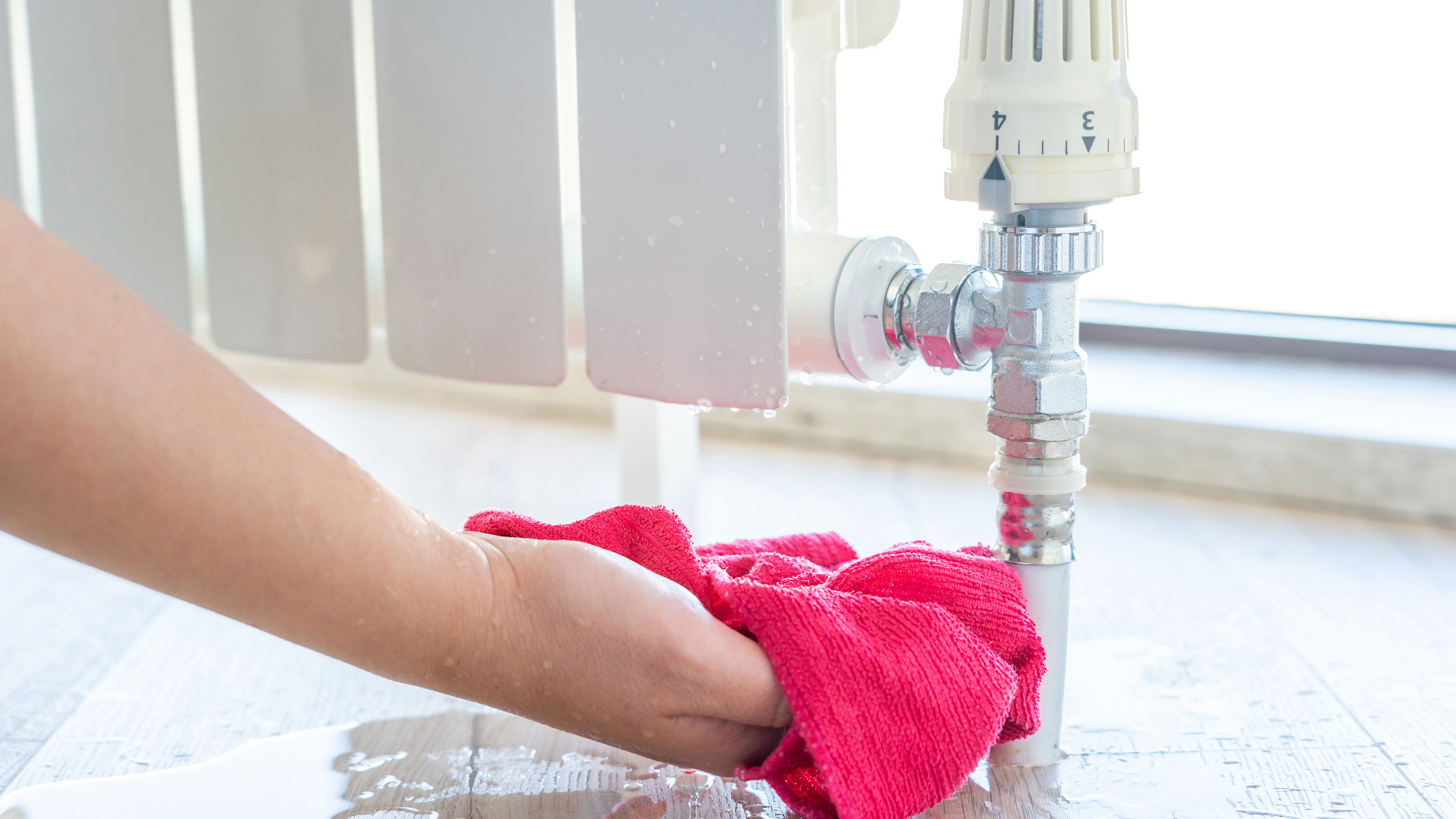Leaking radiators: why it happens and how to fix it
If you've got a leaking radiator, you should try and resolve the issue quickly. This is why it's happening and how to fix it.


A leaking radiator is a problem that needs to be fixed rapidly. Leave it to leak and the water can damage flooring, plus water on the floor is always a potential slip hazard.
What’s more, as with any leak in a central heating system, it’s important to deal with leaking radiators because fresh water that’s drawn into the system can cause scale and corrosion in radiators, and dealing with this will cost you money.
There are a number of reasons why different types of radiators could be leaking, so we’ve got all you need to know about identifying what the issue is, and what the remedy should be, and we’ve asked the experts to provide their top tips, too.
How to fix a leaking radiator
Get on the case as soon as you spot water. ‘If you notice that your radiator is leaking, you should address the issue as quickly as possible so that it doesn’t become a bigger problem,’ advises Chris Harvey, head of marketing at Stelrad.
Discovering which part of the radiator is leaking is the first step, so you can take the appropriate action. Be safe, though. ‘When carrying out these processes, make sure your heating system is off and the radiator is cool,’ cautions Daniel Nezhad, director at UK Radiators. ‘It is also very difficult to identify a leak while the radiator is on.’
Identify where the radiator is leaking
A radiator could be leaking at the radiator valve, pipe joint, spindle, gland, or from its body, and you’ll need to know where the problem lies.
‘Start by drying your radiator completely and then get some toilet roll that you’ll use to place over the radiator’s fixtures,’ says Harvey. ‘Whichever part of the radiator drenches the toilet roll, is undoubtedly the source of the leak.’
Get small space home decor ideas, celeb inspiration, DIY tips and more, straight to your inbox!
Deal with a leak in the body of the radiator
A leak in the body of the radiator is known as a pinhole leak. It might be possible to fix the leak by applying epoxy putty to the radiator. To do so, turn off the water and then drain the radiator. Clean and dry the radiator exterior, then apply the putty to the pinhole area. Let this dry before letting water back into the radiator.
It’s important to be aware that a pinhole leak can be caused by internal corrosion and therefore may require replacement of the radiator with radiator replacement cost varying depending on your location, as well as what the radiator is made from and its size. It is possible to replace a radiator yourself, although you might prefer to call in a pro.
Fix a leak in a radiator valve
If you identified a leak coming from a radiator valve, this is a fix you can undertake yourself if you’re a competent DIYer. But if you’re not confident, call in a plumber.
Before you start switch and with the heating off as you would when bleeding a radiator, lay old towels down. Drain the system to below the leak, too.
Turn off the radiator supply valve that brings water into the radiator, and the valve on the other side. Use a bowl to catch the water which will drip from these.
Then, using an adjustable spanner, undo the union nut connecting the pipe and the radiator. Open the bleed valve to fully drain the radiator, catching the water in a bowl.
Wrap the valve tip with plumber’s tape (PFTE tape) then tighten the union nut. Open the valves. With the water on again, check there are no further leaks before closing the bleed valve.
If the valve continues to leak, be aware that it may require replacement.
Sort out a leak from the radiator gland
If you traced the leak in your radiator to the valve but the water is coming from under the cap, then it could be caused by a problem with the gland.
Turn off the valve first, and the valve on the other side, too, if it continues to leak. Remove the cap and unscrew the gland nut using an adjustable spanner. Wrap plumber’s tape around the spindle of the valve. Finish by pushing some tape into the valve. Screw the gland nut back and replace the plastic cap before turning the valve(s) back on.
Tackle a leaking radiator spindle
You might have located the leak to the connection between the pipework and the radiator, in other words, the spindle. Begin by tightening the nut using a spanner, but if this doesn’t stop the leak, undo it and wrap plumber’s tape around the spindle before tightening up the nut again.
Mend a radiator pipe joint leak
You may have tracked your leak down to the pipes connecting the radiator to the central heating system. A leak at the joint may be fixable simply by tightening it with an adjustable spanner.
If this isn’t sufficient, you will need to drain down the system to below the source of the leak. Next, using a spanner, undo the nut at the joint and free the pipe. Wrap around 8 inches (20cm) of plumber’s tape where the face of the ferrule (or olive) crosses the joint, then tighten the nut but take care not to over tighten.
Is a radiator leak serious?
A radiator leak needn’t be serious, but it definitely needs your immediate attention to prevent water damage to your home. ‘If you do notice a radiator leak, it doesn't necessarily mean you have to buy a new radiator,’ explains Jess Steele, heating expert at radiator specialists BestHeating.
‘Lots of homeowners won't realise that radiator leaks can be caused by extremely simple chemical reactions. Typically, sludge can build up inside radiators, and when left to do its damage, lead to miniscule holes in them, which makes your radiator susceptible to leaks as a result.’
And if yours is an electric radiator? ‘If you have a leak emerging from an electric radiator, then you do need to seek a replacement heating system,’ says Jess.
What causes a radiator to leak from the bottom?
‘If there is water beneath the radiator, in the vast majority of cases this is caused by a faulty radiator valve,’ explains Jordan Chance at PlumbNation. ‘This is usually caused by the internal workings of the valve wearing out over time and no longer being watertight.’
‘If your radiators are past their best, over time a certain amount of corrosion can occur inside the radiator itself,’ Jordan adds. ‘If the corrosion gets serious, it can cause holes to appear at the bottom. The holes usually start off small and brown; rust-filled water will leak out before it becomes a serious problem. If you do notice any holes at the bottom of your radiator, the best thing to do is get it replaced.’

Sarah is a freelance journalist and editor writing for websites, national newspapers, and magazines. She’s spent most of her journalistic career specialising in homes – long enough to see fridges become smart, decorating fashions embrace both minimalism and maximalism, and interiors that blur the indoor/outdoor link become a must-have. She loves testing the latest home appliances, revealing the trends in furnishings and fittings for every room, and investigating the benefits, costs and practicalities of home improvement. It's no big surprise that she likes to put what she writes about into practice, and is a serial house revamper. For Realhomes.com, Sarah reviews coffee machines and vacuum cleaners, taking them through their paces at home to give us an honest, real life review and comparison of every model.